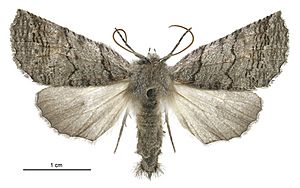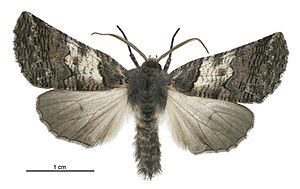Declana griseata facts for kids
Quick facts for kids Declana griseata |
|
|---|---|
 |
|
| Female | |
 |
|
| Male | |
| Scientific classification | |
| Kingdom: | |
| Phylum: | |
| Subphylum: | |
| Class: | |
| Order: | |
| Family: | |
| Genus: | |
| Species: |
D. griseata
|
| Binomial name | |
| Declana griseata Hudson, 1898
|
|
The Declana griseata is a special type of moth that lives only in New Zealand. It belongs to a group of moths called Geometridae, often known as "looper moths" because of how their caterpillars move. Sadly, this moth is currently listed as "At Risk, Declining" by the Department of Conservation, meaning its numbers are going down.
Contents
How Was This Moth Discovered?
This interesting moth was first described and drawn by a scientist named George Vernon Hudson in 1898. He was a very important entomologist (someone who studies insects) in New Zealand. Hudson also wrote more about this moth and drew pictures of it in his books published in 1928 and 1939. The main example specimen, called a lectotype, is kept safe at the Museum of New Zealand Te Papa Tongarewa.
What Does the Declana griseata Look Like?
Scientists have studied and described the different life stages of this moth:
The Larvae (Caterpillars)
The larvae, or caterpillars, of the Declana griseata are quite amazing. They can look very different from one another. What's really cool is that they are masters of disguise! They can perfectly mimic, or copy, the look of a twig on the plant they are eating. This helps them hide from predators.
The Pupae
After the caterpillar stage, the moth enters the pupa stage. The pupae are found on the ground. They are protected inside a cozy cocoon made from moss and bits of plants.
The Adult Moths
The adult moths are a dull, slaty-grey color. The male moths are about 2.8 cm (1.1 inches) wide when their wings are spread out. The females are a bit larger, about 3.5 cm (1.4 inches) wide. Their front wings have a slightly lighter band in the middle. You might also see faint wavy lines and tiny black streaks on their wings. The back wings are a pale grey, getting darker near the edges. The body of the moth is a very dark slaty-grey.
Where Does This Moth Live?
The Declana griseata moth is endemic to New Zealand. This means it is found nowhere else in the world! Its home range stretches from the Bay of Plenty and Taupo areas in the North Island all the way down to Southland in the South Island. However, it might have disappeared from some places in the North Island where it used to live.
Scientists have recorded finding this moth in many different locations, including:
- Wellington
- Top house at Lake Rotoiti
- Mount Hutt
- Castle Hill
- Cave Creek in Paparoa National Park
- Arthurs Pass
- Waiho Gorge in Westland
- Dunedin
- Ben Lomond
- Lake Wakatipu
- Takitimu Mountains in Southland
- Invercargill
- Orepuki
Life Cycle and Habits
The Declana griseata moth has an interesting life cycle:
- Larvae: The caterpillars are usually seen during December and January.
- Adults: The adult moths start to appear from February onwards.
- Flying Season: You can spot these adult moths flying from September all the way through to May.
- Attraction to Light: Like many moths, they are attracted to light.
- Resting Spots: When they are not flying, the adult moths like to rest on mossy tree trunks. They usually choose trees that are close to the plants their caterpillars like to eat.
What Do They Eat?
The caterpillars of the Declana griseata moth have a very specific diet. They feed on leafy mistletoes. One of their favorite host plants is a type of mistletoe called Peraxilla colensoi. The survival of these moths is directly linked to the survival of these special mistletoe plants.
Why Is This Moth "At Risk"?
The Declana griseata moth is classified under the New Zealand Threat Classification System as "At Risk, Declining." This means its population numbers are going down, and it needs our help to survive. Even when it was first discovered by George Hudson, he noted that it was a rare species. The main reason this moth is at risk is because its survival depends entirely on its host plants, the leafy mistletoes. If these mistletoes disappear, the moths will also disappear. Protecting the mistletoe plants is key to saving this unique New Zealand moth.

